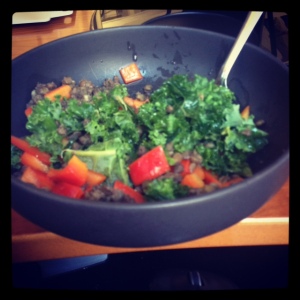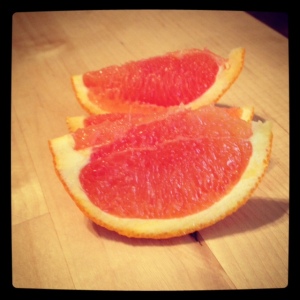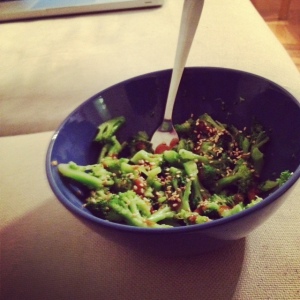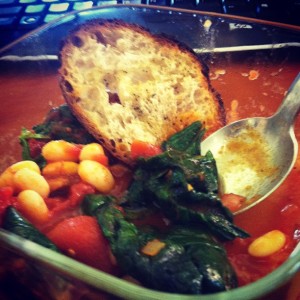Find my published version of this article in the Vanguard here
What’s On The Page:
Heidi Swanson, the cookbook author and blogger behind 101cookbooks.com, has a way

Photo by Adam Wickham
with writing about food, as she proves yet again in her new book “Super Natural Every Day.” Because she was a blogger before she was a cookbook author, Swanson offers substitutions in her head notes, allowing the cook the freedom to work with their pantry, not rush to the store for one specific ingredient.
Although she is a blogger, her prose isn’t so heavily laced with personal stories that we lose sight of what’s really important. Her use of imagery is skillful like a fiction writer, but careful like a chef. It isn’t uncommon to hear her describe a baked good “studded” with dried fruit, or a “flurry” of grated cheese atop a pasta dish. When she does go into personal anecdotes, its skillfully done, usually to give credit to the origins of her recipe ideas (specific friends or farmers).
The table of contents reads a lot like a menu—you get the title of the dish, then two or three standout ingredients to give you an overall sense of what will be making. For example: Sun Toast, whole-wheat seed bread and fresh eggs. Or Chanterelle tacos, Serrano chile, garlic and Parmesan. It’s a unique way of informing the home cook of what each recipe has to offer.
Lastly, it should not go unnoticed how fantastic the photography is in Swanson’s book. All the photos—which Swanson takes herself—do a fantastic job of really capturing the region of Northern California where she lives, as well as the simplistic beauty of the food.
Cuisine:
The strange thing about Swanson’s food (on her blog and in this book) is that you often forget she’s a vegetarian. This may be because Swanson’s recipes are highlights of fresh produce, cheeses and whole grains, and rarely (though sometimes) use meat substitutes like tempeh or seitan. Swanson’s dishes are not stuck on one flavor profile, either. On one page, you find a Harissa dressing with flecks of cilantro, and on another, there may be a baked good that starts with coconut oil. The best thing about the recipes in this book is that she doesn’t spend time trying to convince her reader that her food is healthy and low in calories. That’s a given. Instead, she offers dishes that are unique and flavorful that just happen to be good for you.
What Stands Out:
The element of this book that is different from her first book, “Super Natural Cooking,” is simplicity. Many of the recipes are one-pot ordeals with small lists of ingredients. And nothing is a six-hour effort; the recipes are accessible and relatively easy to put together. Yes, sometimes there will be a less-recognizable ingredient for novice cooks, yet I would argue that part of really getting good at cooking is building a solid pantry, and Swanson helps you do that, one dish at a time.
What’s Not So Great:
Since this book is so successful in so many ways, finding a negative aspect to it is really nit picking. The one problem I have found is in the baking chapter. There can be some strange measurements (like 1 3/4 teaspoon) that can be a little challenging since baking is so precise. Yet this is in no way a reason to avoid the book (hell, it may even be that I’m a pretty pathetic baker myself).
The Verdict:
Heidi Swanson has really found a way to make her dishes accessible and enjoyable. She brings home cooks out of their comfort zones steadily and educationally, and it’s likely you’ll find yourself wanting to make several dishes from the book in one week.
And If You Choose To Meet Her…
Swanson and local baking celebrity Kim Boyce will be holding a meet up/signing at the Cleaners (next to Clyde Common). There will be snacks, a keg of beer and local food site OurFoodShed.com will be offering bags filled with scrumptious food items to go with book purchases. The event goes from 7 to 9 p.m. Friday, April 29, at The Cleaners, 403 SW 10th Avenue and Stark Street.
 This week’s kitchen tip is brought to you by…your freezer. No, I’m not someone that has quarts of homemade chicken stock tucked away between my bags of frozen blueberries and peas. Though I definitely admire those who do. My kind of freeze-planning ahead usually comes from having too much of something or not wanting it to go bad right away. Here are the 4 things I usually have lurking somewhere in my freezer:
This week’s kitchen tip is brought to you by…your freezer. No, I’m not someone that has quarts of homemade chicken stock tucked away between my bags of frozen blueberries and peas. Though I definitely admire those who do. My kind of freeze-planning ahead usually comes from having too much of something or not wanting it to go bad right away. Here are the 4 things I usually have lurking somewhere in my freezer:








